Variability of Environmental Conditions in Postglacial Temperate Lake and Possibilities for Slowing Down Its Eutrophication Process
Abstract
1. Introduction
2. Materials and Methods
2.1. Morphology and Morphometry of Research Lake
2.2. The Catchment of the Studzieniczno-Kłączno-Ryńskie Lake
2.3. External Loading of the Lake with Nutrients
2.4. Methods
3. Results
3.1. Thermal and Oxygen Settings in SKRL Water
3.1.1. Spring Thermal and Oxygen Settings in the Studied Lake
3.1.2. Summer Thermal and Oxygen Settings in the Studied Lake
3.1.3. Autumn Thermal and Oxygen Settings in the Studied Lake
3.2. Content of Nitrogen Compounds
3.3. Content of Phosphorus Compounds
3.4. Content of Organic Matter in Water of SKRL
3.5. Primary Production Indicators
3.6. Electrolytic Conductivity and pH of SKRL Waters
3.7. Principal Component Analysis (PCA) and Pearson Analysis
4. Discussion
4.1. Hydrochemical Characterization
4.2. Conception of Restoration Techniques
4.2.1. The Use of the Curtain to Protect Against the Inflow/Delivery of Pollutants into the Northern Bay of SKRL
4.2.2. The Use of a Pipeline Introducing Surface Water Inflow into the Bottom Zone
5. Conclusions
Supplementary Materials
Author Contributions
Funding
Institutional Review Board Statement
Informed Consent Statement
Data Availability Statement
Conflicts of Interest
References
- Håkanson, L. Origin of lakes and their and physical characteristics. In Encyclopedia of Lakes and Reservoirs; Springer: Dordrecht, The Netherlands, 2012. [Google Scholar] [CrossRef]
- Tundisi, J.G.; Tundisi, T.M. The origin of lakes. In Limnology, 1st ed.; CRC Press: Boca Raton, FL, USA, 2011. [Google Scholar]
- Sun, Z.; Groll, M.; Opp, C. Lake-catchment interactions and their responses to hydrological extremes. Quat. Int. 2018, 475, 1–3. [Google Scholar] [CrossRef]
- Grochowska, J.K.; Tandyrak, R. Water chemistry of Lake Gilwa. J. Elem. 2010, 15, 89–99. [Google Scholar] [CrossRef]
- Raicevic, V.; Bozic, M.; Rudic, Z.; Lalevic, B.; Kikovic, D. The evolution of the eutrophication of the Palić Lake. Afr. J. Biotechnol. 2011, 10, 1736–1744. [Google Scholar] [CrossRef]
- Bhateria, R.; Jain, D. Water quality assessment of lake water: A review. Sustain. Water Resour. Manag. 2016, 2, 161–173. [Google Scholar] [CrossRef]
- Shi, C.; Zhuang, N.; Li, Y.; Xiong, J.; Zhang, Y.; Ding, C.; Liu, H. Identifying factors influencing reservoir eutrophication using interpretable machine learning combined with shoreline morphology and landscape hydrological features: A case study of Danjiangkou Reservoir, China. Sci. Total Environ. 2024, 951, 175450. [Google Scholar] [CrossRef]
- Schoonover, J.E.; Lockaby, B.G. land cover impacts on stream nutrients and fecal coliform in the lower Piedmont of West Georgia. J. Hydrol. 2006, 331, 371–382. [Google Scholar] [CrossRef]
- Vasitha, P.; Ganguly, R. Water quality assessment of natural lakes and its importance: An overview. Mater. Today Proc. 2020, 32, 544–552. [Google Scholar] [CrossRef]
- Qin, B.; Yang, L.; Chen, F.; Zhu, G.; Zhang, L.; Chen, Y. Mechanism and control of lake eutrophication. Chin. Sci. Bull. 2006, 51, 2401–2412. [Google Scholar] [CrossRef]
- Ahmed, T.; Haque, K.; Haque, M.; Khatun, T.; Mahlemb, S.; Shetu, M.S.; Uddin, M.; Hossin, Y. Lake eutrophication mechanism and control: Current status and future tendency. Life Sci. Stud. 2024, 1, 10–31. Available online: https://www.researchgate.net/publication/385653369_Lake_Eutrophication_Mechanism_and_Control_Current_Status_and_Future_Tendency#fullTextFileContent (accessed on 4 October 2025).
- Bhagowati, B.; Ahamad, K.U. A review on lake eutrophication dynamics and recent developments in lake modelling. Ecohydrol. Hydrobiolgy 2019, 19, 155–156. [Google Scholar] [CrossRef]
- Grochowska, J.; Teodorowicz, M. Assessment of potential impact of drainage basins on upper Pasłęka lakes and susceptibility of lakes to degradation. Acta Sci. Pol. Form. Circumiectus 2006, 5, 99–111. (In Polish) [Google Scholar]
- Tandyrak, R.; Teodorowicz, M.; Grochowska, J. Observations of selected chemical components of meromictic Lake Zapadłe waters in 1990–1993, 2000–2001 and 2005–2006. Arch. Environ. Prot. 2010, 36, 75–82. [Google Scholar]
- Vollenweider, R.A. Scientific Fundamentals of the Eutrophication of Lakes and Flowing Waters with Particular Reference to Nitrogen and Phosphorus as Factors in Eutrophication; Organization for Economic Co-operation and Development, Directorate for Scientific Affairs: Paris, France, 1968. [Google Scholar]
- Vollenweider, R.A. Advances in defining critical loading level for phosphorus in lake eutrophication. Mem. Inst. Ital. Hydrobiol. 1976, 33, 53–83. [Google Scholar]
- Akinnawo, S.O. Eutrophication: Causes, consequences, physical and biological techniques for mitigation strategies. Environ. Chall. 2023, 12, 100733. [Google Scholar] [CrossRef]
- Nędzarek, A.; Tórz, A.; Kubiak, J. Oxygen conditions and trophic state of Lake Głębokie (Szczecin, Poland) in year 2008–2010. Limnol. Rev. 2010, 10, 163–172. [Google Scholar] [CrossRef]
- T-Krasznai, E.; Török, P.; Borics, G.; Lukács, A.; Kókai, Z.; Lerf, V.; Görgényi, J.; B-Béres, V. Functional dynamics of phytoplankton assemblages in hypertrophic lakes: Funcional-and species diversity is highly resistant to cyanobacterial blooms. Ecol. Indic. 2022, 145, 109583. [Google Scholar] [CrossRef]
- Grochowska, J.K.; Wiśniewski, G.; Tandyrak, R. Productivity of lakes varying in water mass dynamics. Limnol. Rev. 2011, 11, 7–13. [Google Scholar] [CrossRef]
- Wang, W.; Li, W.; Xue, M.; Gu, X.; Ye Ch Jiao, Y.; Liu, B.; Han, Y.; Tang, Y.; Zhang, X. Spatial-temporal characteristics and influencing factors of lake water and groundwater chemistry in Hulun Lake, northeast China. Water 2023, 15, 937. [Google Scholar] [CrossRef]
- Nowiński, K.; Maślanka, W.; Lange, W. Chemical properties of lakes water. Limnol. Res. 2005, 3, 279–294. (In Polish) [Google Scholar]
- Tammeorg, O.; Kragh, T.; Nürnberg, G.K.; Carvalho, L.; Huser, B.; Jilbert, T.; Augustyniak-Tunowska, R.; Dadi, T.; Friese, K.; Grinberga, L.; et al. Towards sustainable lake restoration. Sci. Total Environ. 2025, 994, 180001. [Google Scholar] [CrossRef]
- Harkonen, L.H.; Lurling, M.; Kang, L.; Augustyniak-Tunowska, R.; Grochowska, J.K.; Jarvinen, M.; Kramer, L.; Łopata, M.; Masi, F.; Rizzo, A.; et al. Innovation in Lake Restoration: Literature Review; Technical Report; FutureLakes: Oslo, Norway, 2025; 55p, Available online: www.futurelakes.eu (accessed on 20 November 2025).
- Kondracki, J. Pomeranian Lake District. In Regional Geography of Poland; PWN Scientific Publishing House: Warsaw, Poland, 2009; 444p. (In Polish) [Google Scholar]
- Members of the American Public Health Association(APHA). Standard Methods for Examination of Water and Wastewater, 24th ed.; American Water Works Association: Denver, CO, USA, 2023. [Google Scholar]
- Tibco Software Inc. STATISTICA, Version 13.3; Tibco Software Inc.: Palo Alto, CA, USA, 2021. [Google Scholar]
- Bengtsson, L. Circulation processes in lakes. In Encyclopedia of Lakes and Reservoirs; Encyclopedia of Earth Sciences Series; Bengtsson, L., Herschy, R.W., Fairbridge, R.W., Eds.; Springer: Dordrecht, The Netherlands, 2012. [Google Scholar] [CrossRef]
- Chikita, K.A.; Oyagi, H.; Amita, K. A thermal regime and water circulation in a very deep lake: Lake Tazawa, Japan. Hydrology 2024, 11, 40. [Google Scholar] [CrossRef]
- Zhan Ch Chen, L. A review of wind-driven hydrodynamics in large, shallow lakes: Importance, process-based modeling and perspectives. Camb. Prism. Water 2023, 1, e16. [Google Scholar] [CrossRef]
- Skowron, R. Criteria of thermal classification of lakes. Bull. Geogr. Phys. Geogr. Ser. 2009, 2009, 89–105. [Google Scholar] [CrossRef]
- Patalas, K. Mixing of water as a factor determining the intensity of matter flow in morphologically different lakes near Węgorzewo. Ann. Agric. Sci. 1960, 77, 223–242. (In Polish) [Google Scholar]
- Liu, S.; Ye, Q.; Wu, S.; Stive, M.J. Horizontal circulation patterns in a large shallow lake: Taihu Lake, China. Water 2018, 10, 792. [Google Scholar] [CrossRef]
- Wetzel, R.G. Limnology, Lake and River Ecosystems; Academic Press: New York, NY, USA, 2001; pp. 1–1006. [Google Scholar]
- Castro, B.F.; Chmiel, H.E.; Minaudo, C.; Krishna, S.; Perolo, P. Primary and net ecosystem production in a large lake diagnosed from high—Resolution oxygen measurements. Water Resour. Res. 2021, 57, e2020WR029283. [Google Scholar] [CrossRef]
- Cao, Y.; Scharfenberger, U.; Shatwell, T.; Adrian, R.; Agasild, H.; Angeler, D.G.; Baklioğlu, M.; Cakiroğlu, A.I.; Hejzlar, J.; Papasterigiadou, E.; et al. Predicting daily net ecosystem production in shallow lakes from dissolved oxygen saturation levels: A pen—European mesocosm experiment and modelling approach. Hydrobiologia 2024, 852, 471–487. [Google Scholar] [CrossRef]
- Karlsson, J.; Byström, P.; Ask, J.; Persson, L.; Jansson, M. Light limitation of nutrient poor lake ecosystems. Nature 2009, 460, 506–509. [Google Scholar] [CrossRef]
- Nara, F.; Tani, Y.; Soma, Y.; Soma, M.; Naraoka, H.; Watanabe, T.; Horiuchi, K.; Kawai, T.; Oda, T.; Nakamura, T. Response of phytoplankton productivity to climate change recorded by sedimentary photosynthetic pigments in Lake Hovsgol (Mongolia) for the last 23,000 years. Quat. Int. 2005, 136, 71–81. [Google Scholar] [CrossRef]
- Romero-Viana, L.; Keely, B.J.; Camacho, A.; Vicente, E. Primary production in Lake La Cruz (Spain) over the last four centuries: Reconstruction based on sedimentary signal of photosynthetic pigments. J. Paleolimnol. 2010, 43, 771–786. [Google Scholar] [CrossRef]
- Liu, X.; Steele Ch Simis, S.; Warren, M.; Tyler, A.; Spyrakos, E.; Selmes, N.; Hunter, P. Retrieval of chlorophyll—A concentration and associated product uncertainty in optically diverse lakes and reservoirs. Remote Sens. Environ. 2021, 267, 112710. [Google Scholar] [CrossRef]
- Karimian, H.; Huang, J.; Chen, Y.; Wang, Z.; Huang, J. A novel framework to predict chlorophyll—A concentrations in water bodies through multi-source big data and machine learning algorithms. Environ. Sci. Pollut. Res. 2023, 30, 79402–79422. [Google Scholar] [CrossRef] [PubMed]
- Faraś-Ostrowska, B.; Lange, W. Transparency of water as a measure of the severity of lake eutrophication. Degradation threats and lake protection. Limnol. Res. 1998, 1, 181–191. [Google Scholar]
- Jamu, D.M.; Lu, Z.; Piedrahita, R.H. Relationship between Secchi disc visibility and chlorophyll a in aquaculture ponds. Aquaculture 1999, 170, 205–214. [Google Scholar] [CrossRef]
- Xu, Z.; Xu, J. Rapid field estimation of biochemical oxygen demand in a subtropical eutrophic urban lake with chlorophyll a fluorescence. Environ. Monit. Assess. 2015, 187, 4171. [Google Scholar] [CrossRef]
- Yiun, Y.; Zhang, Y.; Liu, X.; Zhu, G.; Qin, B.; Shi, Z.; Feng, L. Temporal and spatial variations of chemical oxygen demand in Lake Taihu, China from 2005 to 2009. Hydrobiologia 2011, 665, 129–141. [Google Scholar] [CrossRef]
- Hayakawa, K.; Okamoto, T.; Hirose, Y.; Sato, Y. Quality characteristics indicators in freshwater environments at low concentration levels: Comparison among COD(Mn), BOD and TOC in Lake Biwa catchment. J. Jpn. Soc. Water Environ. 2018, 41, 193–203. [Google Scholar] [CrossRef]
- Lee, J.; Lee, S.; Yu, S.; Rhew, D. Relationships between water quality parameters in rivers and lakes: BOD5, COD, NBOPs, and TOC. Environ. Monit. Assess. 2016, 188, 252. [Google Scholar] [CrossRef]
- Cai, Y.; Wang, H.; Zhang, T.; Zhou, Y.; Dong, A.; Huang, R.; Zeng, Q.; Yuan, H. Seasonal variation regulate the endogenous phosphorus release in sediments of Shijiuhu Lake via water-level fluctuation. Environ. Res. 2023, 238, 117247. [Google Scholar] [CrossRef]
- Wu, X.; Ma, T.; Du, Y.; Jiang, Q.; Shen, S.; Liu, W. Phosphorus cycling in freshwater lake sediments: Influence of seasonal water level fluctuations. Sci. Total Environ. 2021, 792, 148383. [Google Scholar] [CrossRef]
- Boström, B.; Jansson, M.; Forsberg, C. Phosphorus release from lake sediments. Arch. Hydrobiol. 1982, 18, 5–59. [Google Scholar]
- Shaw, J.F.P.; Prepas, E.E. Relationship between phosphorus in shallow sediments and in the trophogenic zone of seven Alberta Lakes. Water Res. 1990, 24, 551–556. [Google Scholar] [CrossRef]
- Augustyniak-Tunowska, R.; Karczmarczyk, R.; Grochowska, J.; Łopata, M.; Napiórkowska-Krzebietke, A.; Lürling, M. Phosphorus inactivation mitigates the effect of warm winters in a temperate shallow lake (Mielenko Lake, Poland). Biogeochemistry 2024, 167, 1234–1267. [Google Scholar] [CrossRef]
- Ye, L.; Xiao, Y.; Qin, J.; Tang, J.; Yin, Y.; Zhang, W. The influence of redox potential on phosphorus release from sediments in different water bodies. Mar. Bull. 2024, 207, 116909. [Google Scholar] [CrossRef]
- Christophoridis Ch Fytianos, K. Conditions affecting the release of phosphorus from surface lake sediments. J. Environ. Qual. 2006, 35, 1181–1192. [Google Scholar] [CrossRef]
- Carey, C.; Rydin, E. Lake trophic status can be determined by the distribution of sediment phosphorus. Limnol. Oceanogr. 2011, 56, 2051–2063. [Google Scholar] [CrossRef]
- Zhan, J.; Han, X.; Brookes, J.D.; Qin, B. High probability of nitrogen and phosphorus co-limitation occurring in eutrophic lakes. Environ. Pollut. 2022, 292, 118276. [Google Scholar] [CrossRef]
- Shahzad, S.; Mehdi, S.E.H.; Sharma, A.; Hussain, F.; Gurung, A.; Kang, W.; Jang, M.; Oh, S.E. Characterization of nitrifying bacteria and exploring a novel approach for toxicity monitoring in water. Environ. Chem. Ecotoxicol. 2025, 7, 106–116. [Google Scholar] [CrossRef]
- Paulsson, O.; Winderlund, A. Algal nutrient limitation and metal uptake experiment in the Akerberg pit lake, northern Sweden. Appl. Geochem. 2020, 125, 104829. [Google Scholar] [CrossRef]
- Müller, B.; Thoma, R.; Baumann, K.B.L.; Callbeck, C.M.; Schubert, C.J. Nitrogen removal processes in lakes of different trophic states from on-site measurements and historic data. Aquat. Sci. 2021, 83, 37. [Google Scholar] [CrossRef]
- Carlson, R.E. A trophic state index for lakes. Limnol. Oceanogr. 1977, 22, 361–369. [Google Scholar] [CrossRef]
- Kratzer, C.R.; Brezonik, P.L. A Carlson—Type trophic state index for nitrogen in Florida lakes. Water Res. Bull. 1981, 17, 713–715. [Google Scholar] [CrossRef]
- OECD (Organisation for Economic Cooperation and Development). Eutrophication of Waters: Monitoring, Assessment and Control; OECD: Paris, France, 1982. [Google Scholar]
- Olszewski, P. Removal of lake hypolimnion. The results of the first year of the experiment on Lake Kortowskie. Zesz. Nauk. WSR 1959, 9, 331–339. (In Polish) [Google Scholar]
- Łopata, M.; Augustyniak, R.; Grochowska, J.; Parszuto, K.; Tandyrak, R. Selected Aspects of Lake Restorations in Poland. In The Mediterranean Sea; Springer Science and Business Media: Berlin, Germany, 2019; pp. 327–352. [Google Scholar]
- Brodzińska, B.; Jańczak, J.; Kowalik, A.; Lamparska, A.; Rekowska, J.; Sziwa, R. Atlas of Polish Lakes; Bogucki Scientific Publishing House: Poznań, Poland, 1997; Volume II. (In Polish) [Google Scholar]
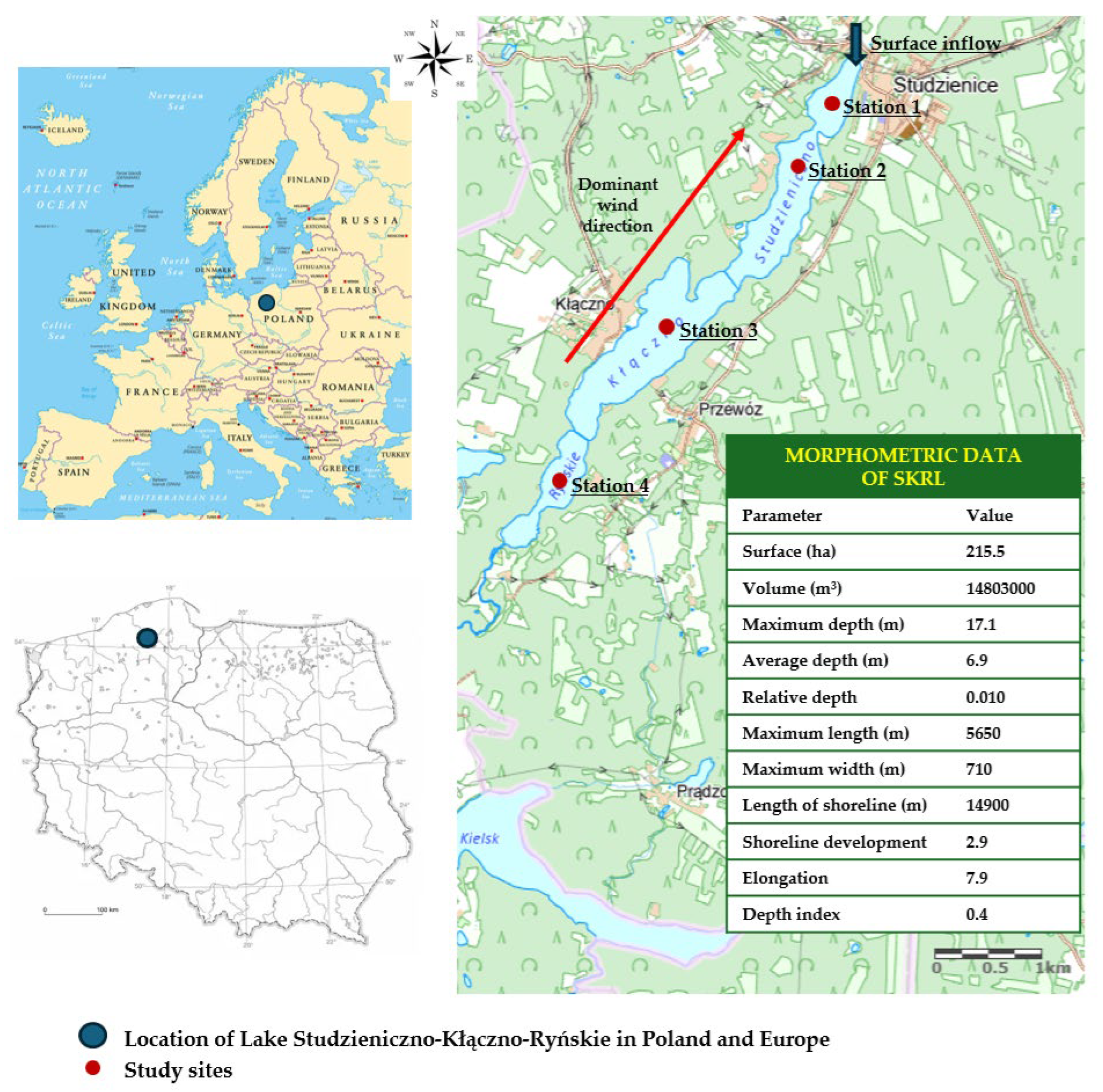
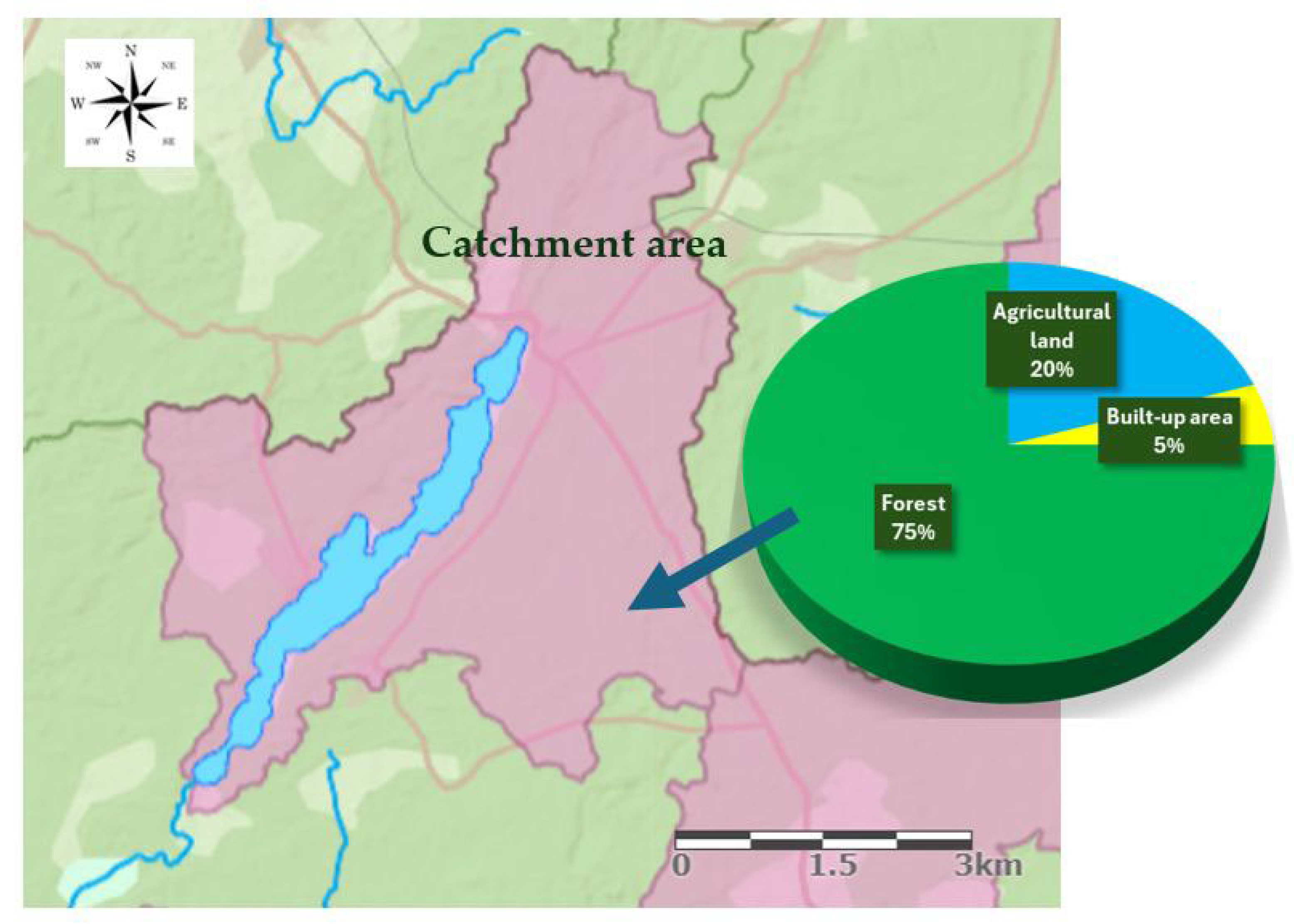
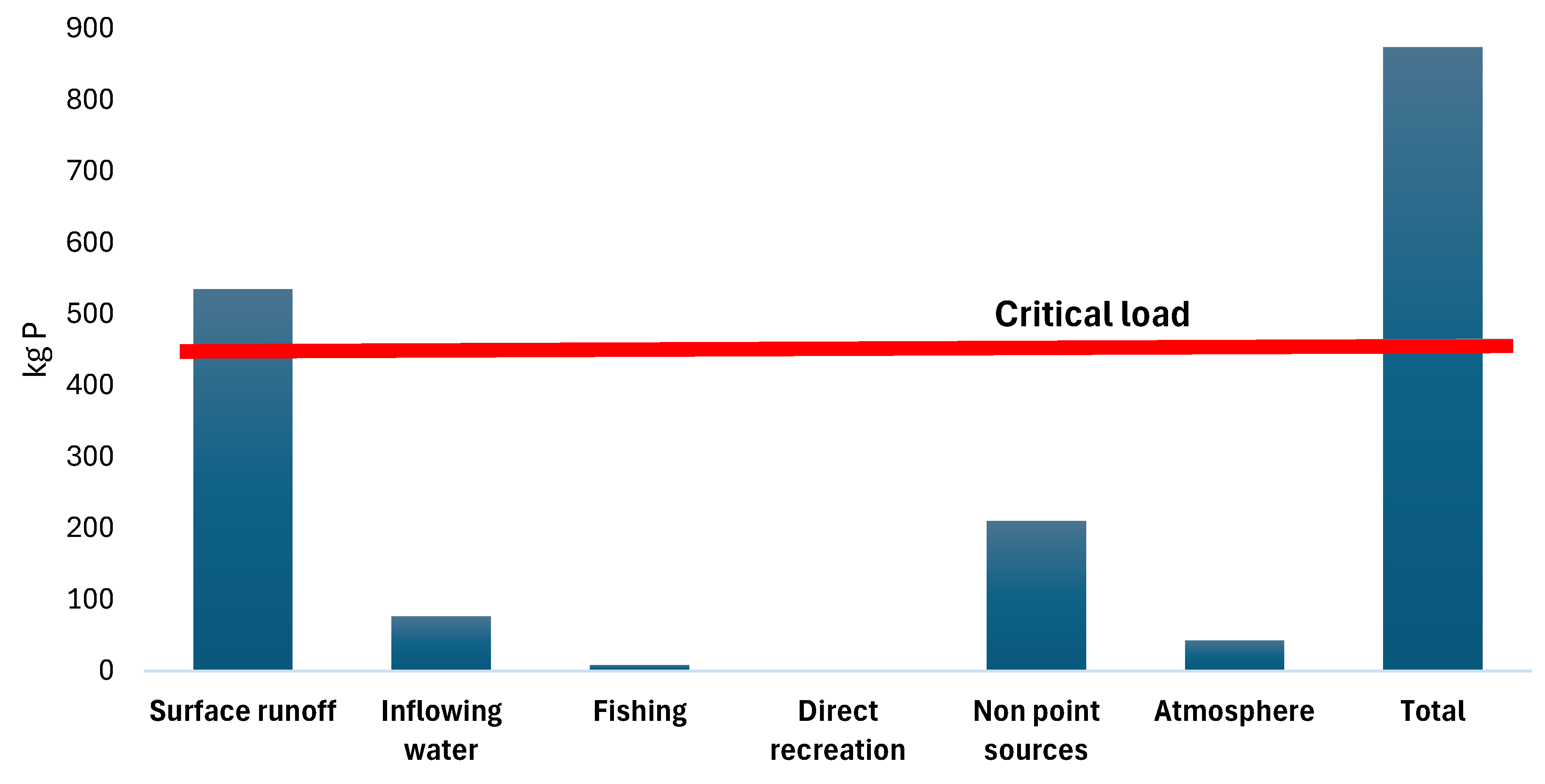
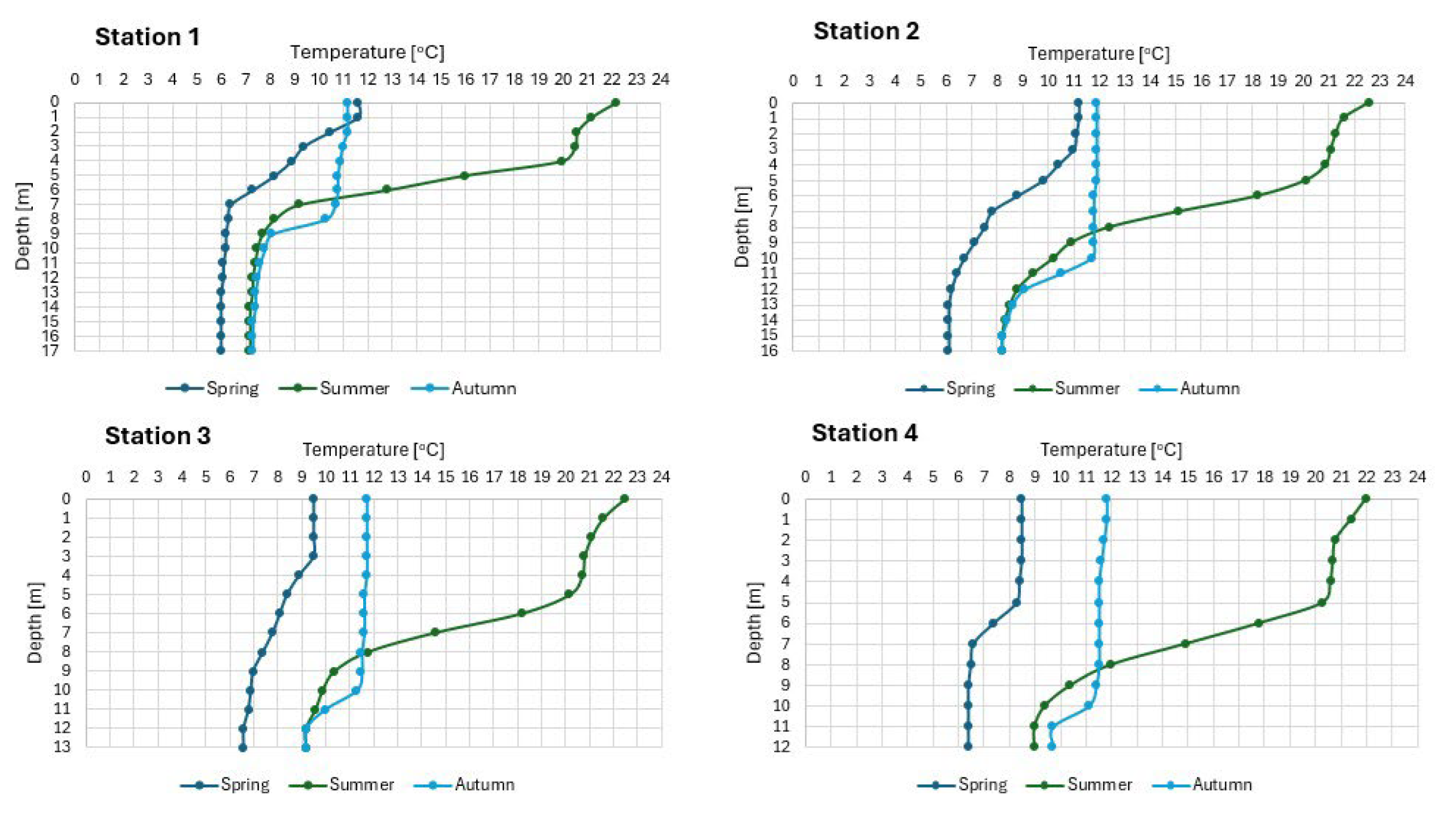
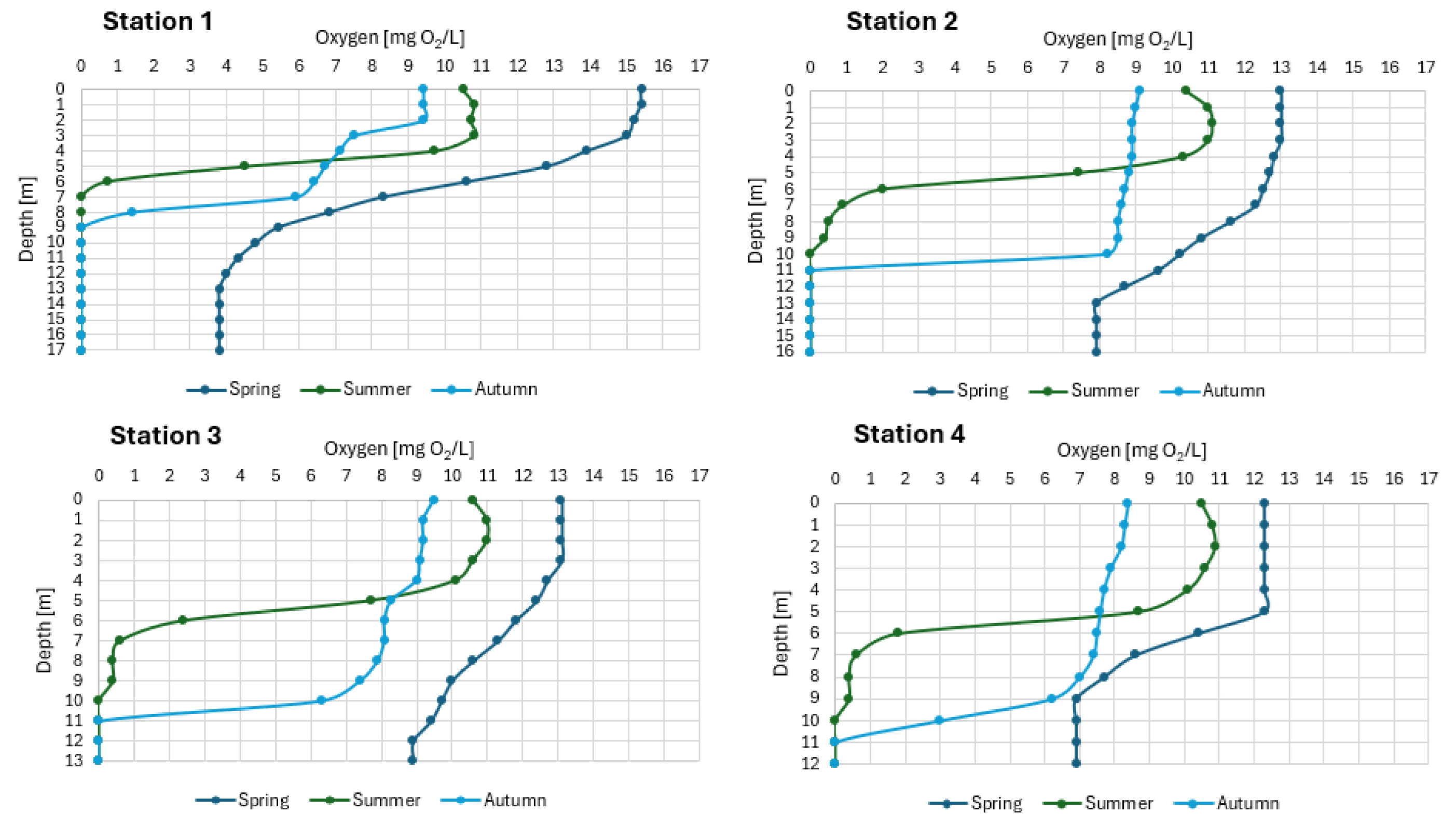

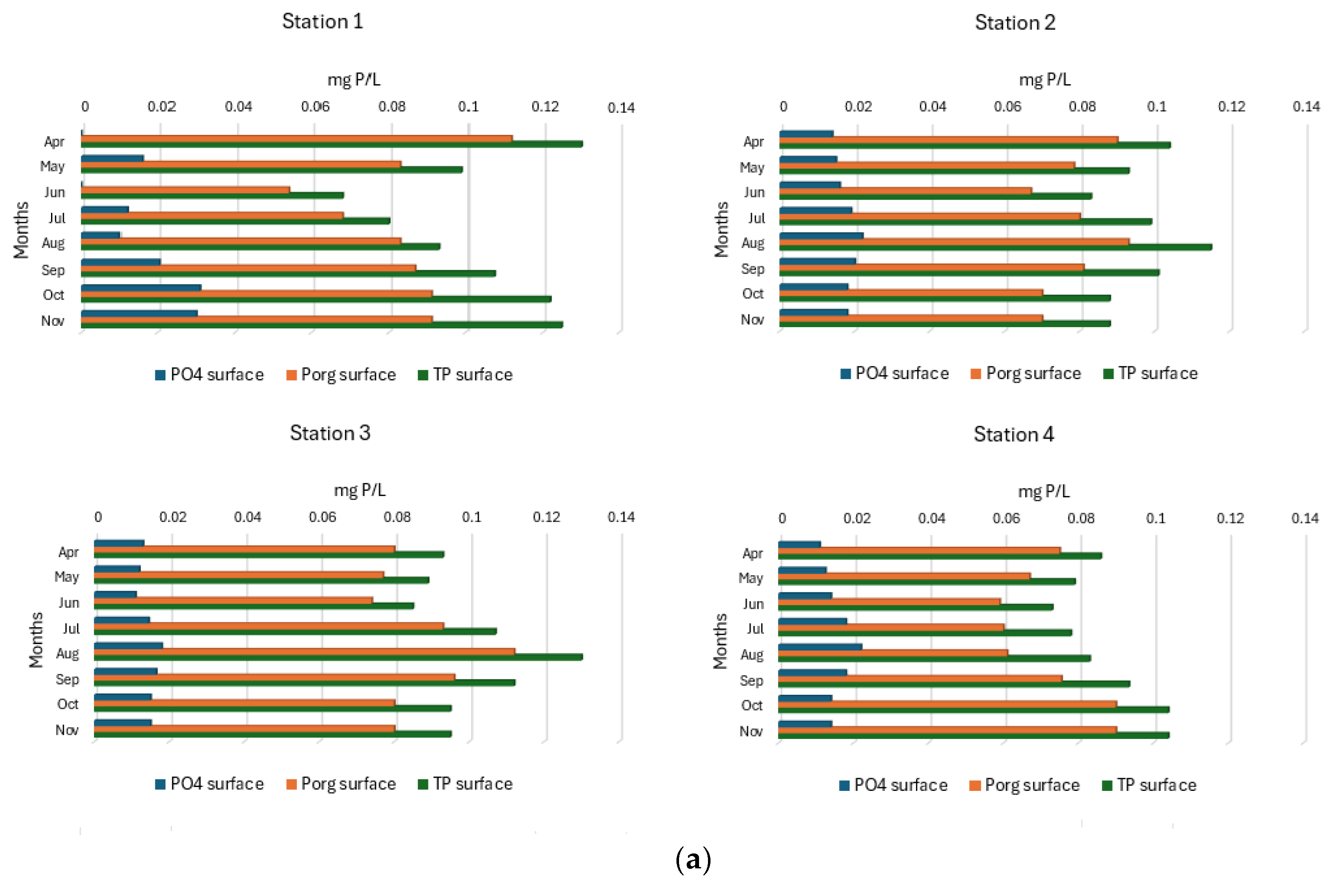
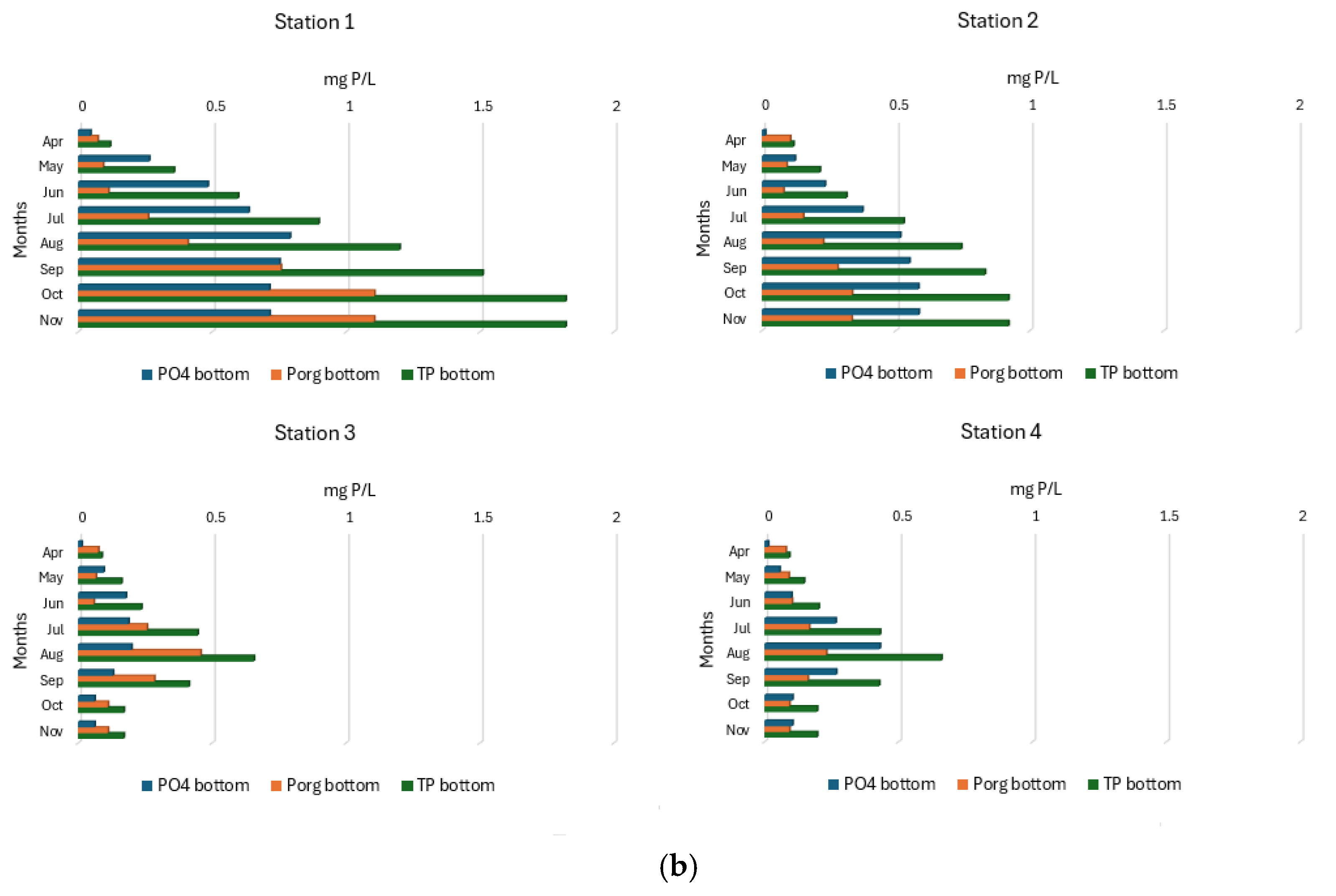
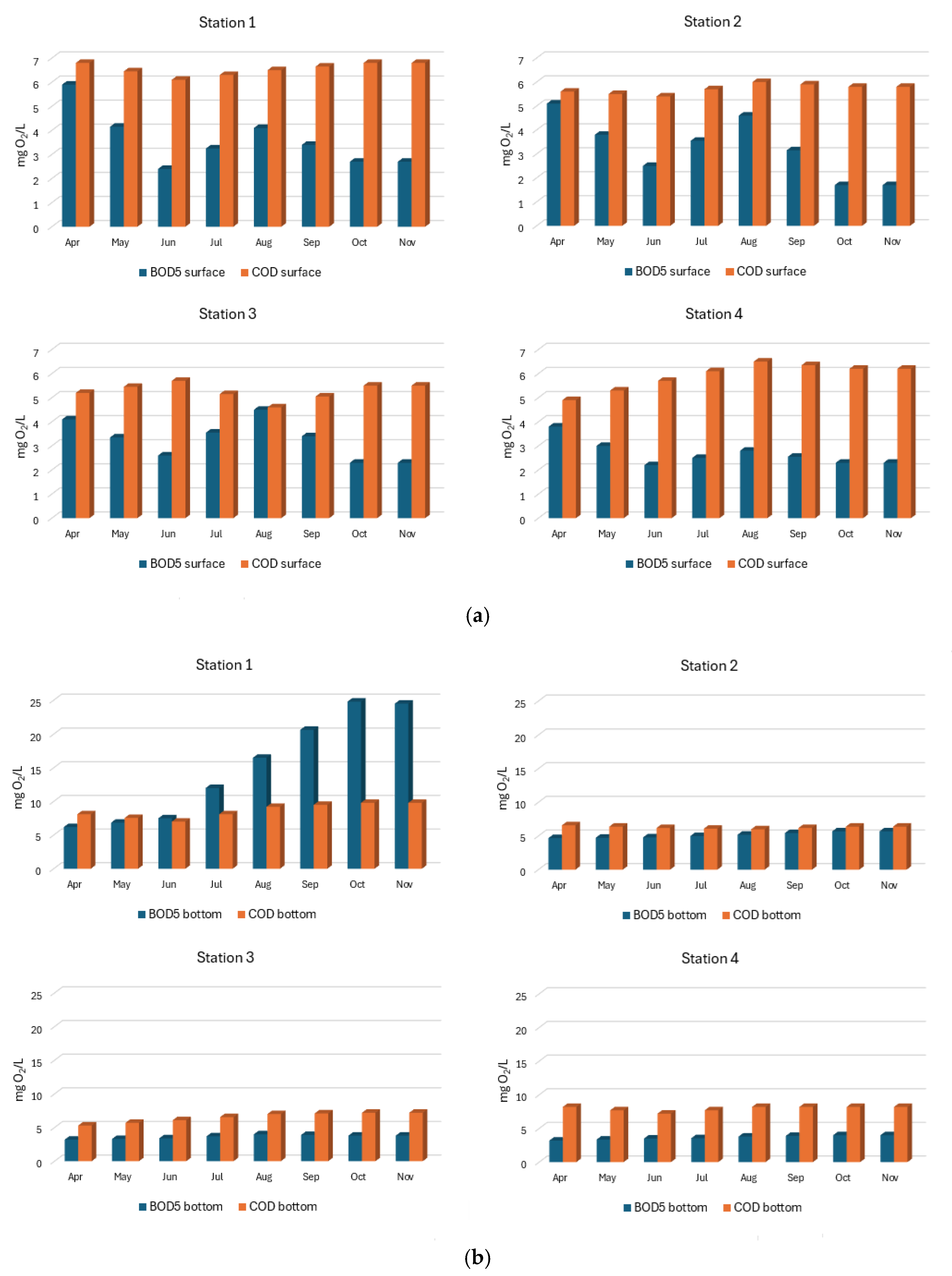
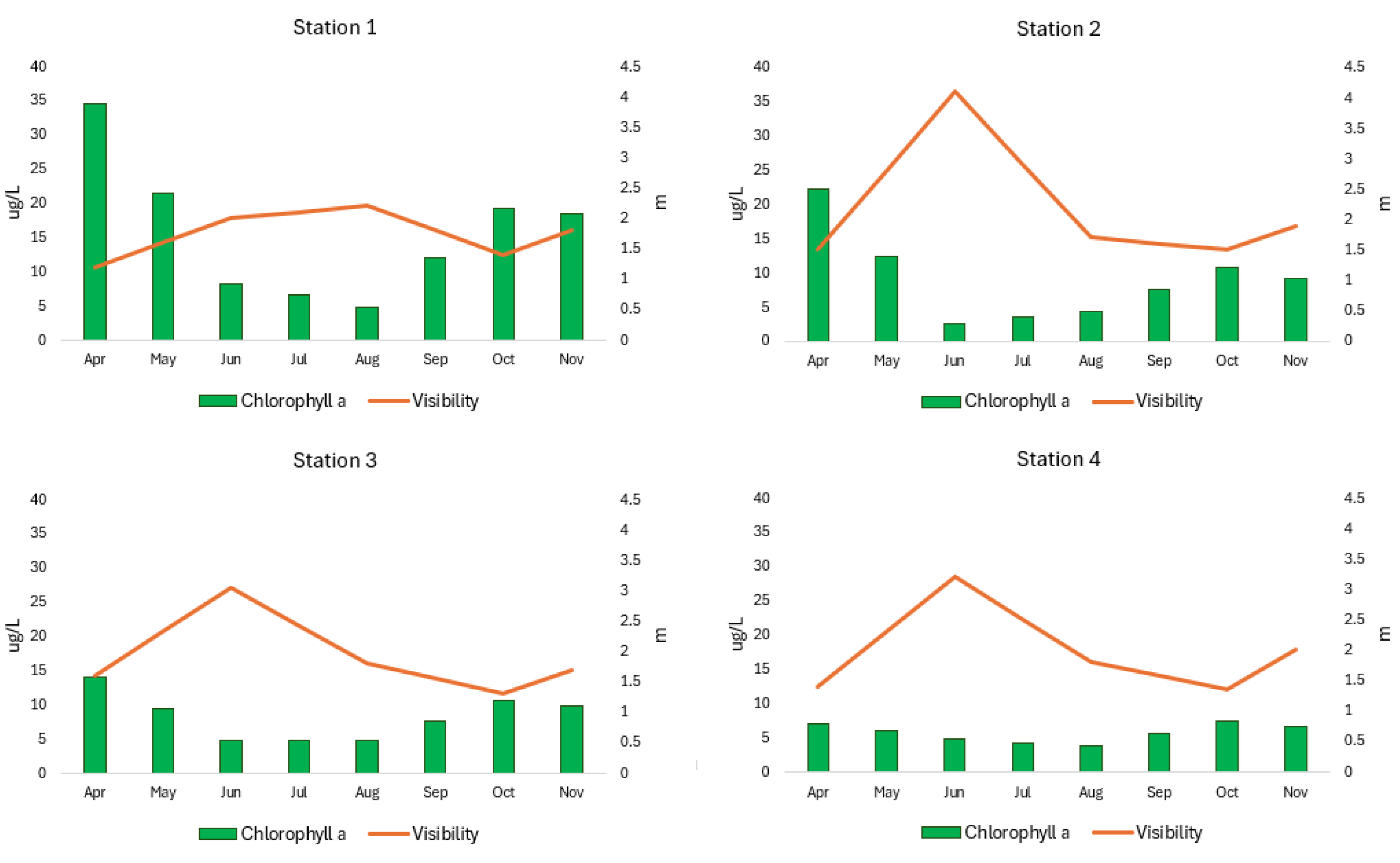
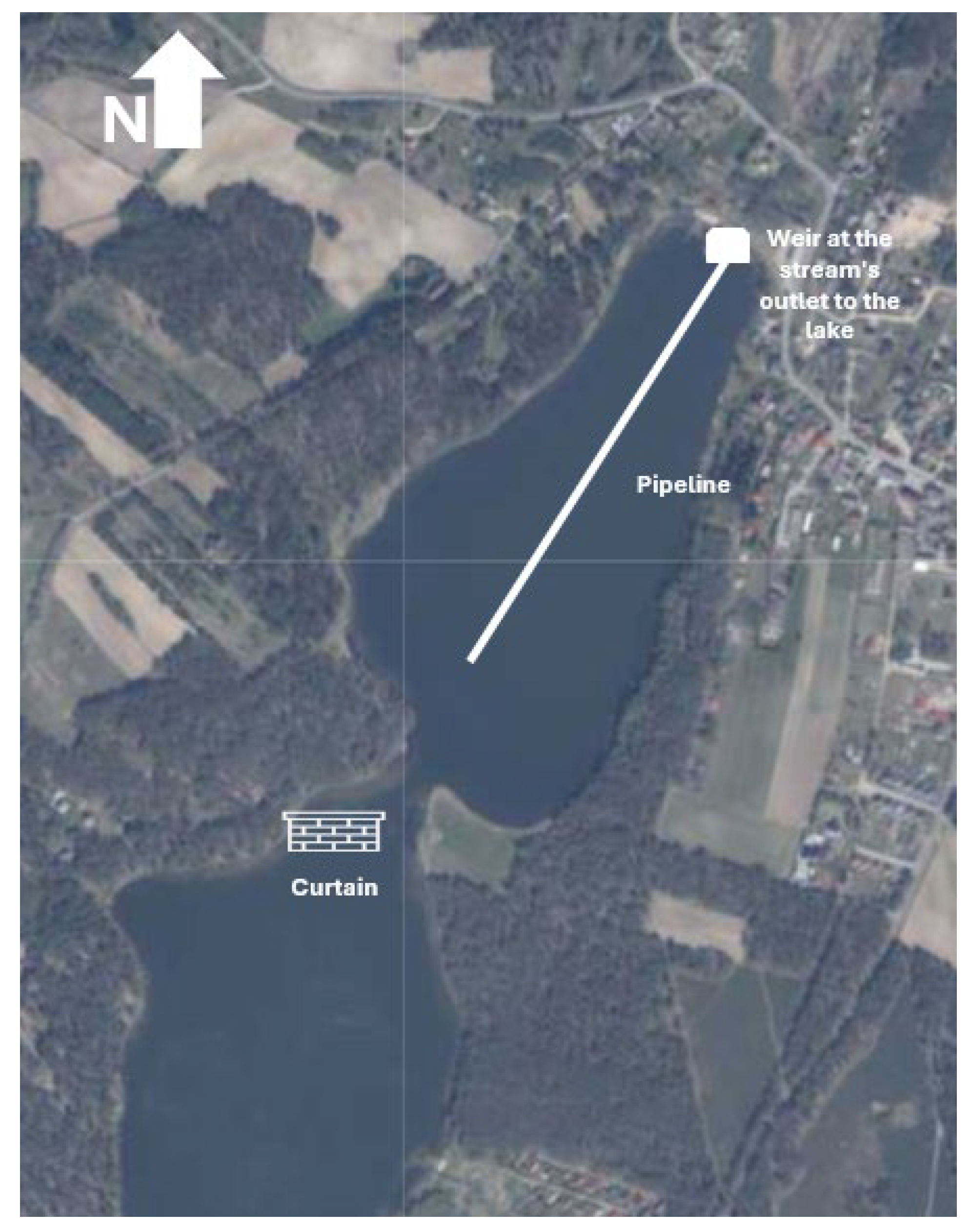
| Parameter | SS Effect | F (Fisher Coefficient F > 1) | p (Significance Level) (p = 0.05) |
|---|---|---|---|
| NH4 SW NH4 BW | 0.00487 14.85004 | 1.590077 3.918888 | 0.0213962 0.018706 |
| NO3 SW NO3 BW | 0.000482 0.092147 | 4.718124 2.199773 | 0.008682 0.110254 |
| Norg. SW Norg.BW | 0.108609 6.704334 | 0.306242 6.133586 | 0.820638 0.002429 |
| TN SW TN BW | 0.13182 37.02095 | 0.322272 4.704296 | 0.809193 0.008795 |
| PO4 SW PO4 BW | 3863.06 0.95600 | 2.334581 8.720212 | 0.095454 0.000304 |
| Porg. SW Porg. BW | 0.000943 0.642342 | 1.775061 3.735576 | 0.174782 0.022422 |
| TP SW TP BW | 0.001122 2.981638 | 1.554416 6.536946 | 0.222482 0.001722 |
| BOD5 SW BOD5 BW | 3.339652 701.8209 | 1.169722 15.16539 | 0.338811 0.000005 |
| COD SW COD BW | 6.796562 30.57156 | 16.75670 21.44869 | 0.000002 0.000000 |
| Chlorophyll | 434.4691 | 3.783061 | 0.021390 |
| Visibility | 0.959184 | 0.669443 | 0.577925 |
| pH SW | pH BW | EC [µS/cm] SW | EC [µS/cm] BW | ||
|---|---|---|---|---|---|
| Station 1 | Average | 8.11 | 6.80 | 300 | 388 |
| SD | 0.658 | 0.527 | 9.196 | 36.197 | |
| Minimum | 7.23 | 6.40 | 283 | 342 | |
| Maximum | 9.10 | 7.90 | 310 | 436 | |
| Station 2 | Average | 8.05 | 6.90 | 272 | 335 |
| SD | 0.601 | 0.546 | 13.887 | 23.760 | |
| Minimum | 7.21 | 6.47 | 246 | 298 | |
| Maximum | 8.82 | 8.02 | 286 | 362 | |
| Station 3 | Average | 8.12 | 7.05 | 270 | 340 |
| SD | 0.614 | 0.539 | 12.822 | 30.229 | |
| Minimum | 7.28 | 6.59 | 247 | 294 | |
| Maximum | 9.00 | 8.18 | 286 | 374 | |
| Station 4 | Average | 8.24 | 7.02 | 272 | 366 |
| SD | 0.616 | 0.533 | 12.351 | 49.343 | |
| Minimum | 7.35 | 6.46 | 250 | 299 | |
| Maximum | 8.99 | 8.05 | 288 | 419 | |
| Index | Station 1 | Station 2 | Station 3 | Station 4 |
|---|---|---|---|---|
| TSITP | 65 | 68 | 68 | 66 |
| TSITN | 41 | 41 | 43 | 41 |
| TSISD | 50 | 40 | 44 | 44 |
| TSIChl | 51 | 39 | 45 | 46 |
| Trophic Type * | Trophic State | OECD |
|---|---|---|
| U–O | I | <5 |
| O–M | I | 5–10 |
| M–E | II | 10–30 |
| E–P | III | 30–100 |
| P | IV | >100 |
| P | V | >100 |
Disclaimer/Publisher’s Note: The statements, opinions and data contained in all publications are solely those of the individual author(s) and contributor(s) and not of MDPI and/or the editor(s). MDPI and/or the editor(s) disclaim responsibility for any injury to people or property resulting from any ideas, methods, instructions or products referred to in the content. |
© 2025 by the authors. Licensee MDPI, Basel, Switzerland. This article is an open access article distributed under the terms and conditions of the Creative Commons Attribution (CC BY) license (https://creativecommons.org/licenses/by/4.0/).
Share and Cite
Grochowska, J.K.; Augustyniak-Tunowska, R. Variability of Environmental Conditions in Postglacial Temperate Lake and Possibilities for Slowing Down Its Eutrophication Process. Appl. Sci. 2025, 15, 12437. https://doi.org/10.3390/app152312437
Grochowska JK, Augustyniak-Tunowska R. Variability of Environmental Conditions in Postglacial Temperate Lake and Possibilities for Slowing Down Its Eutrophication Process. Applied Sciences. 2025; 15(23):12437. https://doi.org/10.3390/app152312437
Chicago/Turabian StyleGrochowska, Jolanta Katarzyna, and Renata Augustyniak-Tunowska. 2025. "Variability of Environmental Conditions in Postglacial Temperate Lake and Possibilities for Slowing Down Its Eutrophication Process" Applied Sciences 15, no. 23: 12437. https://doi.org/10.3390/app152312437
APA StyleGrochowska, J. K., & Augustyniak-Tunowska, R. (2025). Variability of Environmental Conditions in Postglacial Temperate Lake and Possibilities for Slowing Down Its Eutrophication Process. Applied Sciences, 15(23), 12437. https://doi.org/10.3390/app152312437







